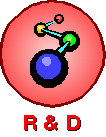
A layperson's guide to

Tandem Mass Spectrometry and Newborn Screening

Introduction
Recent advances in technology and clinical intervention have enabled clinical laboratories providing newborn screening services to improve testing and to expand testing to include additional treatable disorders. One of the major technical advances in newborn screening is the use of an analytical instrument known as a tandem mass spectrometer. Research and development in the newborn screening applications of tandem mass spectrometry were started in the early 1990s and they continue today. More than 20 disorders of body chemistry can be detected in a single analysis of a small blood sample that is collected on a special paper during the first few days of life. The tandem mass spectrometer and how it is used in a newborn screening laboratory is described below. It is hoped that information provided here will create a better understanding of this new powerful technology and the ways that this technology can be used to prevent disabilities and premature death.
What is a mass spectrometer?
A tandem mass spectrometer is one of several types of analytical instruments known as mass spectrometers. Mass spectrometers are used in many laboratories throughout the world to analyze thousands of compounds such as those present in our bodies, our environment, our medicines, manufactured materials, foods, poisons, and criminal evidence. Mass spectrometers can be thought of as instruments that weigh molecules. Of course, molecules are extremely small and cannot be weighed in the traditional sense on a scale. To give you an estimate of the size of a molecule of water, it would take approximately 60,000,000,000,000,000,000,000 water molecules to fill a tablespoon.
Chemists use a mass spectrometer to electronically weigh molecules. We refer to the weight of a molecule as its mass. Every molecule has a unique mass. The mass of water is 18, common table salt (sodium chloride) is 58, and sucrose (from sugar cane) is 342. In addition to identifying a compound by its mass, we can determine how much of the compound is present in the material that we are analyzing. The best analogy that can be used is pocket change. If you grab a handful of coins from your pocket or purse it may consist of pennies, nickels, dimes and quarters. You could sort these coins based on their unique weight and group them so you have perhaps dimes (the lightest coins), pennies, nickels and quarters (the heaviest coin). A mass spectrometer sorts molecules in a fashion analogous to sorting money. Notice that you could also determine how many coins of each type you have in your pocket after sorting into separate groups by counting each group. That is analogous to how a mass spectrometer can measure how much of a compound is present in a mixture.
What is a tandem mass spectrometer?
A tandem mass spectrometer can be thought of as two mass spectrometers in series connected by a chamber that can break a molecule into pieces perhaps like a puzzle. This chamber is known as a collision cell. A sample is sorted and weighed in the first mass spectrometer, then broken into pieces in the collision cell, and a piece or pieces sorted and weighed in the second mass spectrometer.
Why do we need to use a tandem mass spectrometer? The blood samples that we screen hundreds of compounds in them, but we are interested in only a few dozen. It is not practical to identify every compound in the samples that we receive, so we look for compounds of interest to us that have diagnostic significance. Fortunately, the compounds in the blood samples that we analyze have certain common and unique characteristics. These compounds are members of a chemical class or family such as amino acids or fatty acids.
Types of tandem mass spectrometers
A tandem mass spectrometer is often abbreviated as Tandem MS or MS/MS. Sometimes you will also notice the abbreviation ESI (electrospray), FAB (fast atom bombardment) and LSI (liquid secondary ion) before the tandem MS. These terms indicate the way the compound is placed into the tandem mass spectrometer. Photos of two kinds of tandem mass spectrometers using in a newborn screening laboratory are shown below.


How is a tandem mass spectrometer used in a newborn screening laboratory?
The compounds in the blood of infants that we test using tandem mass spectrometry are known as amino acids and acylcarnitines. Amino acids are the building blocks of proteins that become the important parts of our tissues, muscles, organs, blood. Carnitine is a transportation system for fats in and out of the cells energy factory, the mitochondria. When a fat (as a fatty acid) is attached to carnitine it is called an acylcarnitine. We often identify acylcarnitines by the size of the fat molecule attached to it. These may be categorized simply as short, medium and long chain fats or denoted by a combination of letters and numbers. For example, the important medium sized fat attached to carnitine, that is measured in the disorder MCAD (medium chain acylCoA dehydrogenase) deficiency, is an eight carbon fatty acid knows as octanoylcarnitine and is abbreviated C8. The tandem mass spectrometer can weigh this molecule and all of the other acylcarnitines as well and tell us how much is present. The results produced by the mass spectrometer display the data as vertical lines distributed across a horizontal axis (called a mass spectrum). Where the vertical line occurs in the spectrum identifies a compounds mass while the height of the line represents how much of the compound there is.
Why are the measurements of amino acids and acylcarnitines important?
In inherited metabolic diseases, specific enzymes (catalysts) that helps facilitate the breakdown of amino acids or the conversion of fat to energy do not function. If a particular enzyme is not functioning, the breakdown of a compound by this enzyme (metabolism) to waste products does not occur. In other instances, products are not produced that are important in generating fuel for the cell. Because the compound can not be metabolized, it will accumulate in the blood and tissues. The compound in excess then becomes a poison rather than a normal substance. The tandem mass spectrometer, by measuring the amounts of amino acids or acylcarnitines in blood, can tell us using special computer software and expert medical interpretation, whether there is too much of the compound that we analyzed in the blood. This information is communicated to the pediatrician and together with other information will indicate what additional tests are needed to confirm the presence of an inherited disease. If confirmed, treatment of the inherited disorder is started. Treatment of these diseases most often involves changes in the diet that may include fat or protein restriction and/or special vitamin supplements. The pediatrician will probably collect blood samples occasionally to insure that a normal body chemistry is restored and if not, whether the diet must be changed to increase or decrease protein or fat intake.
Why use mass spectrometry?
Research has shown that tandem mass spectrometry can improve laboratory analyses because it is very specific in its identification of the compounds we are interested in, it is very accurate and can measure very small amounts of material with excellent precision. More importantly, it has the ability to measure more than one compound simultaneously in a single, two minute analyses. Other newborn screening tests do not currently exist for measuring acylcarnitines and so tandem mass spectrometry must be used to detect metabolites produced in MCAD deficiency.
For amino acid disorders such as PKU, tandem mass spectrometry has been shown to reduce the false positive rate (false alarms) for this disorder by more than 10 fold compared to the best alternative method available. In addition, much rarer disorders such as MSUD (maple syrup urine disease), citrullinemia, VLCAD (Very Long Chain Acyl CoA dehyrdogenase) deficiency, GA-I and GA-II, propionic academia and methylmalonic acidemia can be detected, simultaneously.
What are the limitations of tandem mass spectrometry?
Tandem mass spectrometers are complex instruments. The methods used to prepare the samples for analysis by mass spectrometry require specialize reagents. Although tandem mass spectrometry is often called a simple blood test, it is not a simple method. Tandem mass spectrometry requires several expert scientists to perform the analyses and medical experts to interpret the large amount of clinical data produced from the analysis of a blood sample. The instruments are expensive and in order to achieve appropriate cost/benefit for analyses of blood samples, it is necessary to screen many tens of thousands of samples per year. In addition, tandem mass spectrometry can not affect problems with blood sample collection and delivery to a laboratory nor the speed at which results are communicated to the physician. Mass spectrometry is a tool that could expand the disorders screened for in qualified newborn screening laboratories having sufficient experience with the technology.
The Future
In excellent laboratories, tandem mass spectrometry will become a powerful tool to expand newborn screening and to significantly improve newborn testing for many diseases. Tandem mass spectrometry and other forms of mass spectrometry will likely be used to analyze other treatable disorders or to improve existing tests so that more accurate and more comprehensive testing will be available. We are at a new horizon in screening and with new treatments available and under development, our future generations will benefit.
Submitted by
Dr. Donald H. Chace, Ph.D., M.S.F.S.
Section Chief
Division of BioAnalytical Chemistry and Mass Spectrometry
Neo Gen Screening
x-13
(fax)
Dr. Chace is one of the primary investigators that developed the newborn screening application of tandem mass spectrometry. He was an assistant medical research professor in the department of Pediatrics at at Duke University Medical Center from 1990-1997. He joined Neo Gen Screening in May of 1997 to develop high throughput mass spectrometry for screening hundreds of samples a day as well as to develop computer interpretation systems to assist physicians in diagnosing metabolic disorders such as MCAD deficiency. During the Year 2000, over 1 million newborn samples will have been analyzed at Neo Gen Screening. He is currently working with the CDC to develop quality assurance systems for newborn screening of inherited metabolic diseases as well as new mass spectrometry methods to detect additional diseases to improve the quality of life for newborns and their families.







[Home] [Info] [News] [Sales] [R&D] [Staff] [Results]
© 2000 Neo Gen Screening. All rights reserved.


![]()
![]()

